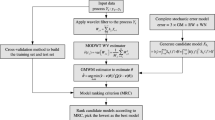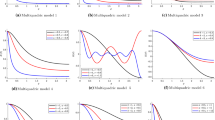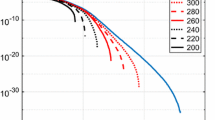Abstract
The Input–Output System Theory (IOST) method is primarily based on the spectral combination of heterogeneous data taking into account their statistical properties and approximating the Power Spectral Density (PSD) functions of the signals and their errors. In this study a Multiple Input–Multiple Output System (MIMOS) is proposed, where the input measurements as well as the input and output signals are different gravity field observables. The work presents a sensitivity analysis of the IOST method towards the input data noise and the effect of integral kernel modifications to the error prediction estimates. Simulated input noise fields along with the contribution of the input data resolution to the output prediction errors are investigated towards the analysis of the 2D error covariance functions. Special attention is paid to the contribution of different kernels to the error prediction estimates and 2D planar and spherical discrete kernels are tested considering the overall prediction improvement of the spectral procedure. The MIMOS system is finally assessed by a number of numerical tests and conclusions are drawn in terms of the optimal modelling of the input data noise and the significance of the spherical kernels in the improvement of the prediction results.
Access this chapter
Tax calculation will be finalised at checkout
Purchases are for personal use only
Similar content being viewed by others
References
Andritsanos VD, Tziavos IN (2000) Estimation of gravity field parameters by a multiple input/output system. Phys Chem Earth 25(A):39–46
Andritsanos VD, Sideris MG, Tziavos IN (2000) A survey of gravity filed modeling applications of the Input-Output system Theory (IOST). Int Geoid Serv Bull 10:1–17
Andritsanos VD, Sideris MG, Tziavos IN (2001) Quasi-stationary sea surface topography estimation by the multiple input-output method. J Geod 75:216–226
Bendat JS, Piersol AG (1986) Random data – analysis and measurements procedures, 2nd edn. Wiley, New York, NY
Forsberg R, Sideris MG (1993) Geoid computations by the multi-band spherical FFT approach. Manuscripta Geodaetica 18:82–90
Haagmans R, de Min E, van Gelderen M (1993) Fast evaluation of convolution integrals on the sphere using 1D FFT and a comparison with existing methods for Stokes’ integral. Manuscripta Geodaetica 18:227–241
Kay SM (1987) Modern spectral estimation. Prentice Hall, Englewood Cliffs, NJ
Lemoine FG et al. (1998) The development of the join NASA GSFC and NIMA geopotential model EGM96, NASA Technical Paper, 1998 – 206861
Li J (1996) Detailed marine gravity field determination by combination of heterogeneous data. UCSE Rep. no 20102, University of Calgary, Canada
Liu QW, Li YC, Sideris MG (1997) Evaluation of deflections of the vertical on the sphere and the plane: a comparion of FFT techniques. J Geod 71:461–468
Marple SL (1987) Digital spectral analysis with applications. Prentice Hall, Englewood Cliffs, NJ
Pavlis NK, Holmes SA, Kenyon SC, Factor JK (2008) An earth gravitational model to degree 2160: EGM2008, presented at the 2008 General Assembly of the European Geosciences Union, Vienna, Austria, 13–18 April 2008
Sailor RV (1994) Signal processing techniques. In: Vanicek P, Christou NT (eds) Geoid and its geophysical interpretations. CRC, Ann Arbor, MI, pp 147–185
Sansò F, Sideris MG (1997) On the similarities and differences betweeen systems theory and least-squares collocation in physical geodesy. Bollettino di Geodesia e Scienze Affini 2:174–206
Sideris MG (1984) Computations of gravimetric terrain corrections using fast Fourier transform techniques. USCE Rep. no 20007, University of Calgary, Canada
Sideris MG (1987) Spectral methods for the numerical solution of Molodensky’s problem. USCE Rep. no 20024, University of Calgary, Canada
Sideris MG (1996) On the use of heterogeneous noisy data in spectral gravity field modelling methods. J Geodesy 70(8):470–479
Tziavos IN (1995) Comparisons of spectral techniques for geoid computations over large regions. J Geodesy 70:357–373
Author information
Authors and Affiliations
Corresponding author
Editor information
Editors and Affiliations
Rights and permissions
Copyright information
© 2012 Springer-Verlag Berlin Heidelberg
About this paper
Cite this paper
Andritsanos, V.D., Tziavos, I.N. (2012). A Sensitivity Analysis in Spectral Gravity Field Modeling Using Systems Theory. In: Kenyon, S., Pacino, M., Marti, U. (eds) Geodesy for Planet Earth. International Association of Geodesy Symposia, vol 136. Springer, Berlin, Heidelberg. https://doi.org/10.1007/978-3-642-20338-1_49
Download citation
DOI: https://doi.org/10.1007/978-3-642-20338-1_49
Published:
Publisher Name: Springer, Berlin, Heidelberg
Print ISBN: 978-3-642-20337-4
Online ISBN: 978-3-642-20338-1
eBook Packages: Earth and Environmental ScienceEarth and Environmental Science (R0)




